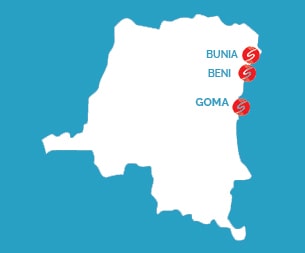INTERVIEW –The Ebola virus returned to the DRC just one year ago and the number of cases continues to increase. More and more cases have surfaced in urban areas, notably in the eastern part of the country, in Goma – a city with a population of two million. “On-site, the teams have been preparing for many months”, explains Justine Muzik Piquemal, Central Africa desk manager.
It is now official. As of August 2nd 2019, 4 Ebola cases have been reported in the large city of Goma in the eastern part of the Democratic Republic of the Congo. These 4 confirmed cases are to be added to the 2.560 others already recorded over the past year (including more than 1.780 deaths). In response to the epidemic, our teams are preparing: modifying safety thresholds, implementing procedures, vaccination, health and behavioral instructions, etc.
In the DRC, we’re currently talking about an Ebola epidemic in the communities.”
Why is this disease so scary?
Its lethality rate! For the DRC, we are talking about 67%. This means that if you contract the disease, you have less than 40% chances surviving! This fear also comes from the fact that the disease is extremely contagious. Finally, unlike the 2015 epidemic in West Africa, where patients were concentrated mainly in cities and hospitals, in the DRC? We are currently talking about an Ebola epidemic in the communities. It is at the very heart of villages and families that the disease strikes. It’s therefore much more difficult to trace the patients and their contacts.
How are SOLIDARITÉS INTERNATIONAL teams involved?
For now, we have been operating in areas where the disease is present (Butembo, Bunia, Beni) in parallel to implementing classic humanitarian programs. To date, we haven’t got a specific program dedicated to fighting this disease. In the next few weeks, we might start working on water, hygiene and sanitation programs in addition to Ebola alerts. Access to drinkable water – chlorinated-, being a key and indispensable element to fight against the disease.
In 2015, Solidarités International’s teams were strongly involved in the Ebola response within a treatment center in Sierra Leone… Is the approach different in DRC?
In reality, as explained previously, in the DRC, we are facing an Ebola epidemic in the communities. So instead of setting-up big treatment centers where the patients would be regrouped, smaller treatment units are set-up to reach the heart of the communities.
How are SOLIDARITÉS INTERNATIONAL teams protected ?
In order to reduce risks and prevent contamination, SOLIDARITÉS INTERNATIONAL has implemented precautions measures and strict hygiene procedures in living areas and during the implementation of humanitarian activities. These procedures include, amongst other things, a strict follow-up of the health of SOLIDARITÉS INTERNATIONAL’s staff in the DRC and when they leave the country.
Help uS to counter the Spread of EBOLA
Photo : Gwenn Dubourthoumieu / SOLIDARITÉS INTERNATIONAL
Democratic Republic of Congo (DRC)
Context and action- 107 millions inhabitants
- 179th out of 191 countries on the Human Development Index
- 524.327 people helped

